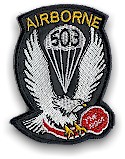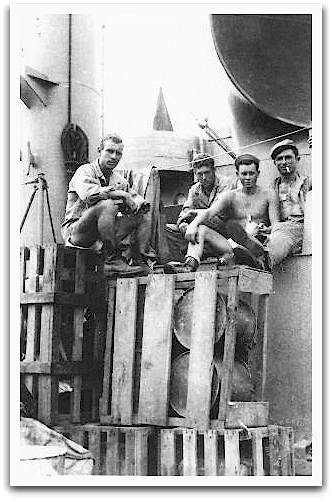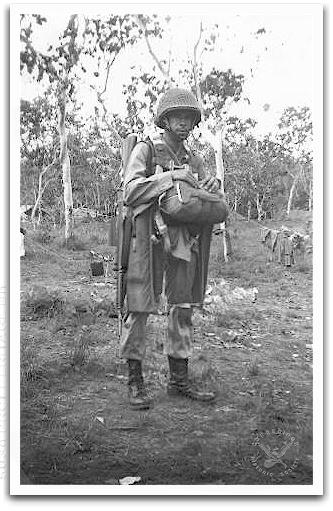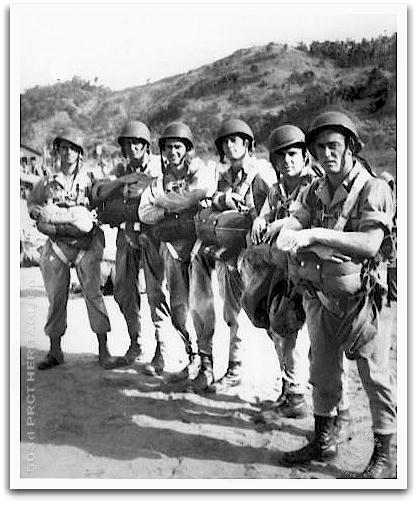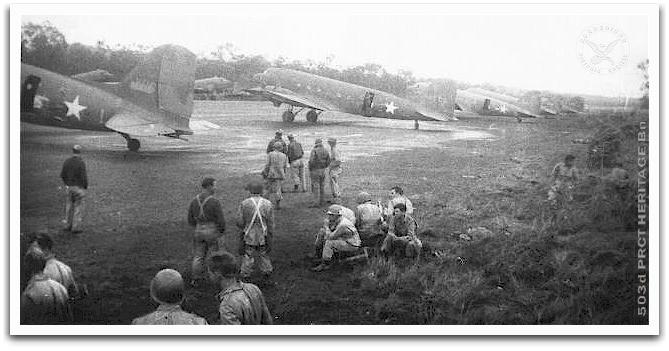|
-6-
Having the Company Executive Officers of the Second Battalion jump with the
first wave in the morning worked out well. The Companies were able to get
themselves organized much faster than they would have otherwise.
The writer served in Company "E" of the Second Battalion. He knew more about the
activities of its Companies (Headquarters, "D", "E" and "F") than what went on
in the First and Third Battalion. With that in mind, the following will deal
with some of the actions of those Companies.
By 1400 hours Company "E"'s platoons were organized and in their positions down
at the base of the hill below the Mile Long Barracks. The Company CP had been
set up two thirds of the way to the west of the middle of the Mile Long
Barracks. Twenty one men had been injured in the jump or wounded in action.
First Lieutenant Dick E. Atchison had broken a leg on the jump. His third
platoon was taken over by Second Lieutenant Lewis B. Crawford who had been the
Assistant Platoon Leader of the first platoon under First Lieutenant Joe M.
Whitson, Jr..
The third platoon, under Lt. Crawford, moved out with the mission of seizing and
securing the old Hospital Building, the most conspicuous feature in the Company
area of responsibility. The other platoons formed a base around the old
Commissary Building, a short distance from the Hospital.
A patrol from the First Platoon was sent down to the area of the Senior Non
Commissioned Officers Quarters to extricate PFC Andrew J. Rabinko and Pvt. Pace
who had been pinned down by a Japanese Machine Gun.
At the end of the first day on Corregidor we had five men missing in action.
They were Staff Sergeants Leonard R. Ledoux and Edward Gulsvick and PFC's Emory
N. High, Matthew D. Musolino and Jimmie T. Rovolis.
Early in the morning of 23 February Company "E" relieved Company "B" of the
First Battalion down near the base of Crocket Ravine on the South Shore Road.
All First and Third Battalion companies were withdrawn to Bottomside on the
morning of 23 February. The men who had been on the go from the time they had
landed on the island had an opportunity to get cleaned up a bit, shave and get
something to eat which was a little better than the "K" rations they had been
stuck with. There, also, was plenty of fresh water for drinking and coffee
making.
At about 0300 of 24 February three strong explosions shook Malinta Hill, with
flames coming from all entrances. Somewhat later two more explosions shook the
hill with flames again pouring out of the entrances. Since neither the 503rd or
the 34th Infantry were
initiating any actions at that time, the explosions were assumed to have been
set off by the Japanese occupying the tunnel.
The interlude of rest and recovery by the First and Third Battalions was not to
last long because Colonel Jones, his staff, Major Robert Woods and Lt. Colonel
John Erickson were cooking up a new mission for the two battalions. The plan was
for the First Battalion to pass through the 3rd Battalion of the 34th Infantry
and push an attack toward the eastern end of the Island. The Third Battalion of
the 503rd was to bring up the rear and mop any islands of Japanese defenders
which the First Battalion had left. The 3rd Battalion of the 34th Infantry
continued to occupy a line across the middle of the Island, astride Malinta
Hill.
The Second Battalion was to maintain its base at Topside and continue its
aggressive patrol activities and wipe out any remaining Japanese troop pockets.
While the Western end of the island, including Topside, was considered "under
control" there were a good many Japanese left. None of these were ready to
surrender voluntarily. Some were forced out of their hiding places and mowed
down by small arms fire. Others had their caves or tunnels closed by demolition
men. While not participating in the big push toward the tail of the island with
the First and Third Battalions, the Second Battalion would continue to be well
occupied.
Elements of the First Battalion began the attack toward the East end of the
Island at 0830 sharp on 25 February. The movement, while fast enough for the men
who were in the lead, seemed like a snail’s pace to the main body of the First
and Third Battalions. The route of the attack was so narrow, and astride a ridge
known to us as Water Tank Hill.
For the 503rd, which had been used to fighting a self-sufficient war with little
help from any other source, having Naval and Air Corps assistance was a welcome
oddity. With the further assistance of the 75 mm guns of the 462nd Parachute
Artillery Battalion the advancing Battalions were getting more support than our
infantry had ever seen.
Malinta Hill sat astride the middle of Corregidor. At that point the Island is
about 900 yards wide. Little room was left on either the North or South side for
roads. To the south the South Shore Road edged its way along a narrow shelf. On
one side of the road was a near-sheer cliff of about 100 feet leading down to
the water. On the other was the cliff leading up to the south end of the ridge,
which Malinta Hill really is. The road on the north side begins at sea level and
climbs to about a hundred foot elevation over a distance of about three hundred
yards.
That is a slope of over 10 percent, hardly a level surface. At that point the
road really begins to get steep. It climbs another hundred feet in about 150
yards. Such pitches even put a strain on the two tanks which were to accompany
the attacking forces.
Tanks were an entirely new phenomena to the 503rd. In the jungles the outfit had
been operating in they would have been of little value so, in the most part,
they were held back until MacArthur's troops landed in the Philippines where
some of the land lent itself to tank operations. Now, however, the 503rd found
it strange having this potential tool at their disposal. Few, if any, of the
Officers and men had any experience in tank warfare and, as a consequence,
failed to take full advantage of the support they could have provided.
Where the initial slope really became steep, the troops encountered the Northern
entrance to Malinta Tunnel. This entrance, in reality the outside entrance to
the Hospital Lateral, was suspicious since it was not known if there were any
Japanese troops in the tunnel who were still in condition to provide a threat.
The 34th Infantry had been in the area but the 503rd was experienced enough in
fighting the Japanese to know they could not take neutralization of the entrance
for granted.
As one of the tanks was abreast of the Hospital entrance about 50 Japanese
swarmed out of the entrance in a Banzai attack. Fire from the tank wiped them
out.
Lithe did either the 503rd or the 34th Infantry know that there were two
significant air shafts which surfaced above and to the side of this entrance.
While the shaft led up at a steep forty five degree angle from the Hospital area
they allowed Japanese, in limited numbers, to come and
go to
harass the troops as they crept past. These entrances held the advancing column
for some time while a good deal of firepower and explosives was spent on it. The
experiences with tunnels and caves on the western part of the island had not
been lost on the troops.
Once the leading elements reached the top of the second, and steeper of the two
slopes, the road leveled. While Water Tank Hill loomed ahead, it was possible to
see a good deal of the Eastern part of the island reaching out to the extreme
end at Hooker Point.
Concurrent with the main column heading up the North Shore Road, a patrol had
followed the rugged shore line, keeping even with the main body higher on the
Malinta Hill. This patrol passed Malinta Point and encountered the old Enlisted
Men's bathing beach. Remains of the shark net installed to protect swimmers from
the marauders could still be made out just below the surface of the water. Then
the patrol rounded Engineer Point and made its way around Artillery Point. The
Officers Swimming Beach opened up before them. But, much to their surprise, a
whole fleet of small boats was beached along the shore line. Upon
investigation, it became evident this was the base of the "Q" Boats we had
heard about. Unknown to us boats had been very active on the day and night
before the 503rd had jumped. A fleet of them had attacked our naval ships and
landing craft in the Mariveles Harbor. Now a number of the craft were up on
rails ready for launching into the North Channel to attack any of our ships
which tried to enter Manila Bay. Other of the boats were under cover back in
tunnels which had been bored back into the cliff. There originally, had been
well over a hundred of these "Q" Boats, which the Japanese called Shin-Yo-Tai,
when the unit left Japan. The boats were about twenty feet long with a freeboard
of about a foot--not designed for long trips in the open seas. Consequently,
many of the boats had been lost on the move from Japan. The United States
military forces, with its huge war machine, would have moved boats like this
utilizing large, sea- going vessels. The Japanese military machine was then
stretched
to its limits. Given
the resources they had to work with, the Japanese did not have adequate shipping
facilities
to move the boats.
By 5 o'clock in the afternoon advance elements of "A" Company had reached Camp
Point, beyond the 92nd Garage area. "C" Company was nearing Infantry Point but
were meeting stiff resistance. Because night comes on fast in the Philippines in
February, the Battalions began to settle while it was still light enough to see
what was going on. The First Battalion set up its Command Post in a large bomb
crater.
|

